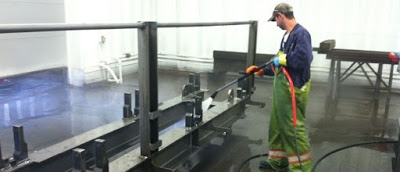
There are a variety of methods that will clean and remove soils from metals. The pretreatment method used is determined by the part to be coated (size, configuration, material), the type of soil to be removed (dust, wax, oil, etc.), and the performance requirements of the finished product. This process of pretreatment requires three steps. The first two steps are explained in detail below, and look for the third step in a later blog.
1. CLEANING
Mechanical cleaning – includes methods like scratch brushing and sand blasting. This abrasive action not only removes the surface impurities but also eliminates scratches and surface irregularities. Mechanical cleaning is sometimes the only way to remove excessive dirt, rust, or scale but can be labor intensive and expensive.
Chemical cleaning – includes removal of dirt, oil, and grease present on the surface by means of chemicals. The chemicals may be applied by wiping, spraying, or dipping, which depends on the soils to be removed, the size and type of the part, the type of coating to be applied, and the substrate material.
2. RINSE
Proper rinsing between process stages removes any remaining contaminated solutions from the substrate surface and is essential for successful pretreatment and coating performance.
Pretreatment is the base for powder coating. The highest quality powder coating will show you excellent results ONLY if the pretreatment is done correctly, maximizing the benefits of powder coating. Oily patches, pin holes, rust spots, reduced resistance to weather, and overall poor powder coating performance will result with improper pretreatment.

Have a question about pretreatment? Contact our technical help today for advice from an expert. Or you can always reference our trouble shooting guide online first.